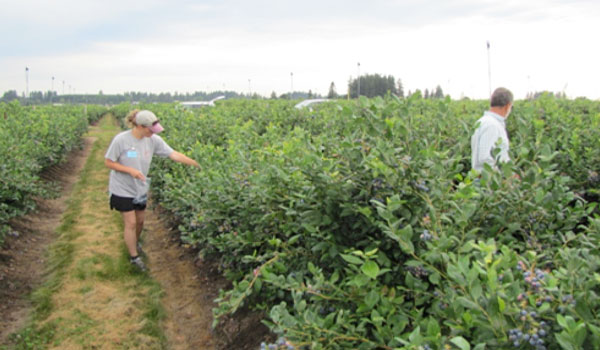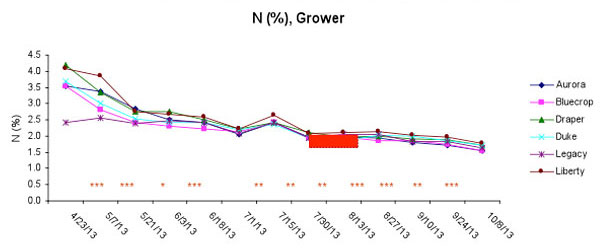
Tissue Testing in Blueberry –
When's the Right Time and Do Cultivars Differ?
Bernadine Strik, Professor of Horticulture & Berry Research Program Leader, OSU
Gil Buller, Senior Faculty Research Assistant, NWREC
Amanda Vance, Faculty Research Assistant, OSU
Key questions that need to be answered with regard to any nutrient management program are: How much nutrient should be applied? When is the best time to apply the nutrient? What source of the nutrient or what material is best to apply? And what method of application is best?
How much nutrient should be applied is often estimated using soil and plant tissue testing, experience, observations of plant growth and information on the amount of nutrient generally required for good growth and production. Nutrient availability and plant nutrient status are assessed by soil and tissue testing. Please refer to our publication Nutrient Management for Blueberries in Oregon, EM 8918, available online at Oregon State University (http://extension.oregonstate.edu/catalog/). I encourage everyone working with commercial berry crops to access these and other publications on soil sampling, modifying soil pH, etc.
Here we will just focus on tissue testing and let you know what we are presently working on.
Leaf tissue analysis provides information on the nutrient content of the plant – sometimes even when soil nutrient content is adequate, the plant is not able to take up the nutrients required (e.g. soil pH is incorrect; dry or saturated soil; weather; cultural issues such as over cropping, irrigation, etc.). Tissue standards have been developed using results from research experiments and estimated from large databases that relate tissue nutrient levels to good yielding fields for each crop (OSU). The present tissue standards for northern highbush blueberries are in Table 1.
Table 1. Suggested critical levels for leaves of lateral shoots of northern highbush blueberry when sampled in late-July to early-August in the Pacific Northwest.

Note that these standards are the same for all cultivars. We have wondered if standards and/or sampling time might need to differ between early- and late-fruiting cultivars.
Well-designed research experiments are needed in many berry crops to improve tissue standards.
We started a two-year study in summer 2013 to determine the effect of blueberry cultivar and leaf sampling time on tissue nutrient concentration. We also sampled ripe fruit to determine if cultivars differ in the amount of nutrient removed per ton of fruit harvested.
This study is being conducted in well established plantings of blueberry. Treatments are replicated four times:
Site:
- Certified organic with compost/sawdust mulch or with weed mat
- Conventionally managed with very little mulch still present
Cultivar (at each site):
- Duke, Draper, Bluecrop, Liberty, Legacy, Aurora
The organic planting is at the NWREC whereas the conventional is at a grower-collaborator site. The plantings are both drip irrigated (except for Bluecrop at the grower site) and have similar fertilization programs (total macro- and micro-nutrients applied) although only OMRI approved fertilizers are used at the organic site. No foliar fertilizers are being used at either site.
At each site and for each cultivar/rep combination, tissue samples of the most recent fully-expanded leaf were collected every two weeks from late April (when shoots were large enough for sampling) to early October. Samples were sent to a commercial analytical lab for analysis of nutrient content (C, N, P, K, S, Ca, B, Mg, Mn, Zn, Cu, Fe, Al). Observations were made of plant developmental stage at leaf sampling time, harvest season and yield. Ripe fruit were collected from the second harvest date in each cultivar and analyzed for fruit nutrient levels.
 |
Amanda Vance and Gil Buller sampling leaves for tissue analysis at grower site, 2013 |
We shared our full findings to date at winter grower meetings in Oregon and Washington. While we have only one year’s data so far, it seems clear that the concentration of most nutrients changes considerably during the growing season, making it clear that sampling leaves at the correct time is critical for consistency of results.
For example, tissue nitrogen (%N) is considerably higher in spring than in summer (Figures 1 and 2). In contrast, leaf Ca increases during the season (Figures 3 and 4). Cultivars also differed for many nutrients (see Figure 2 for example). Interestingly, the cultivars differed little in leaf %N during the recommended sampling time, despite having very different fruiting seasons (Figures 1 and 2).
We are repeating the study this season and will use the data to determine if we have enough information to change the recommended tissue standards for blueberry. Stay tuned.
Figure 1 - Tissue Nitrogen

Figure 2 - Tissue Nitrogen
 Figure 3 - Tissue Calcium Figure 3 - Tissue Calcium
 Figure 4 - Tissue Calcium Figure 4 - Tissue Calcium
 |
